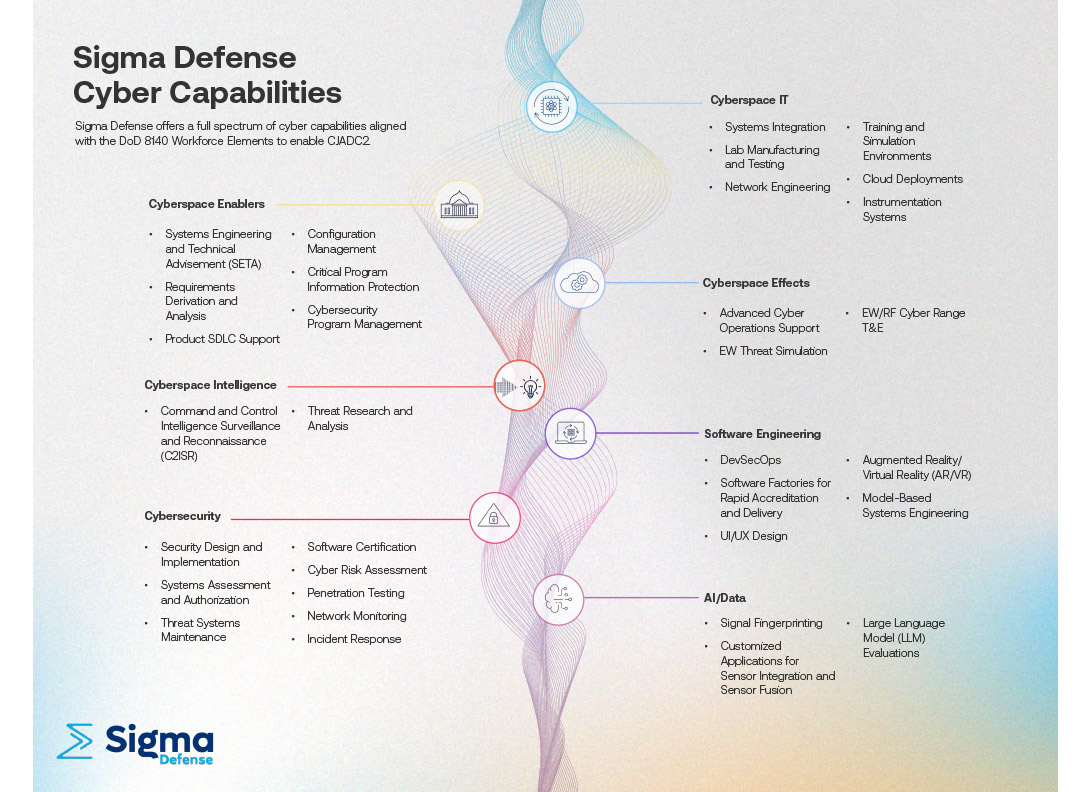
What is CSfC?
The Commercial Solutions for Classified (CSfC) program was instituted to develop trusted systems and deliver secure capabilities quickly to the DoD, Intelligence Community and federal civilian agencies by leveraging commercial technologies and products.
CSfC was implemented by the National Security Agency (NSA) and founded on the data security principle that two completely independent layers of encryption, each from a different accredited commercial vendor can provide adequate protection of classified data in a variety of different applications.

Sigma Defense CSfC Capabilities
Engineering—Since 2006, Sigma Defense has provided COTS systems integration, cybersecurity engineering, and custom solution design for unique mission sets around the globe. We leveraged that solution engineering experience to implement CSfC pre-tested and pre-approved Capability Packages (CP) that can be tailored to specific user requirements to provide complete end-to-end solution.
Trusted Integrator—Sigma Defense partners with organizations designated at Trusted Integrators by the NSA to bring together CSfC components that align with the CSfC CPs to ensure the solution meets or exceeds security standards and delivers proper functionality.
Benefits of Sigma Defense CSfC
Supply Chain Risk Reduction: Virtualization of network components reduces reliance on hardware procurement and long lead times.
Embedded Cybersecurity: Security is “baked in” based on approved CSfC capability packages.
Operational Resilience: A vendor-agnostic virtualized network environment results in a more agile and reliable network infrastructure.
RMF Agility: Security requirements are mapped and addressed during the network planning and design stage, shortening the authorization cycle.
Bespoke CSfC Integration: Hybrid hub configuration supports diversity based on customer needs.
Scalability: Can be replicated to multiple sites based on a pre-approved configuration.
Cost Reduction: A lightweight repeatable model that reduces overhead and cost factors.
CSfC Use Cases at Sigma Defense
- NiaB
- SDN-A™
- Olympus
Network in a Box (NiaB)
NiaB is an all-in-one ready-to-use secure network connectivity solution based on a hardware-agnostic design that leverages Commercial Solutions for Classified (CSfC) components. The NiaB is a responsive and adaptable capability that can be rapidly deployed to a wide range of geographically dispersed organizations, and that can be replicated and scaled to support future use cases.

Software Definable Network Appliances™ (SDN-A™)
Building upon a legacy of delivering secure, small form factor networking equipment, Sigma Defense has a created integrated CSfC solutions that are portable, robust, software programmable communications solutions for secure voice, video and data feeds over a variety commercial network technologies including Ethernet, Wi-Fi, Cellular, MANET, SATCOM and more.

Olympus
Sigma Defense incorporates the CSfC Tactical Capability Package and Multi-Site Connectivity Capability Package into a vendor agnostic MOSA platform eliminating Type 1 encryption. Olympus enables a true CJADC2 environment providing the ability to:
- Ingest unstructured/structured data from Multi-INT remote sensors through diverse transport topologies
- Process data via locally hosted AI and ML tools
- Aggregate “enriched” data for dissemination across a common fabric for data sharing and federation with Joint and Partner forces
- Powered by an accredited DevSecOps environment for agile software development, infrastructure automation, and a CI/CD pipeline

CSfC is a critical component of the NSA’s commercial cybersecurity strategy to quickly deliver secure cybersecurity solutions through commercial technologies. Founded on the principle that properly configured, layered solutions can provide adequate protection of classified data in a variety of different applications CSfC protects data from threats that attempt to exploit national security system networks.
Learn more about how Sigma Defense can help protect your classified data.


